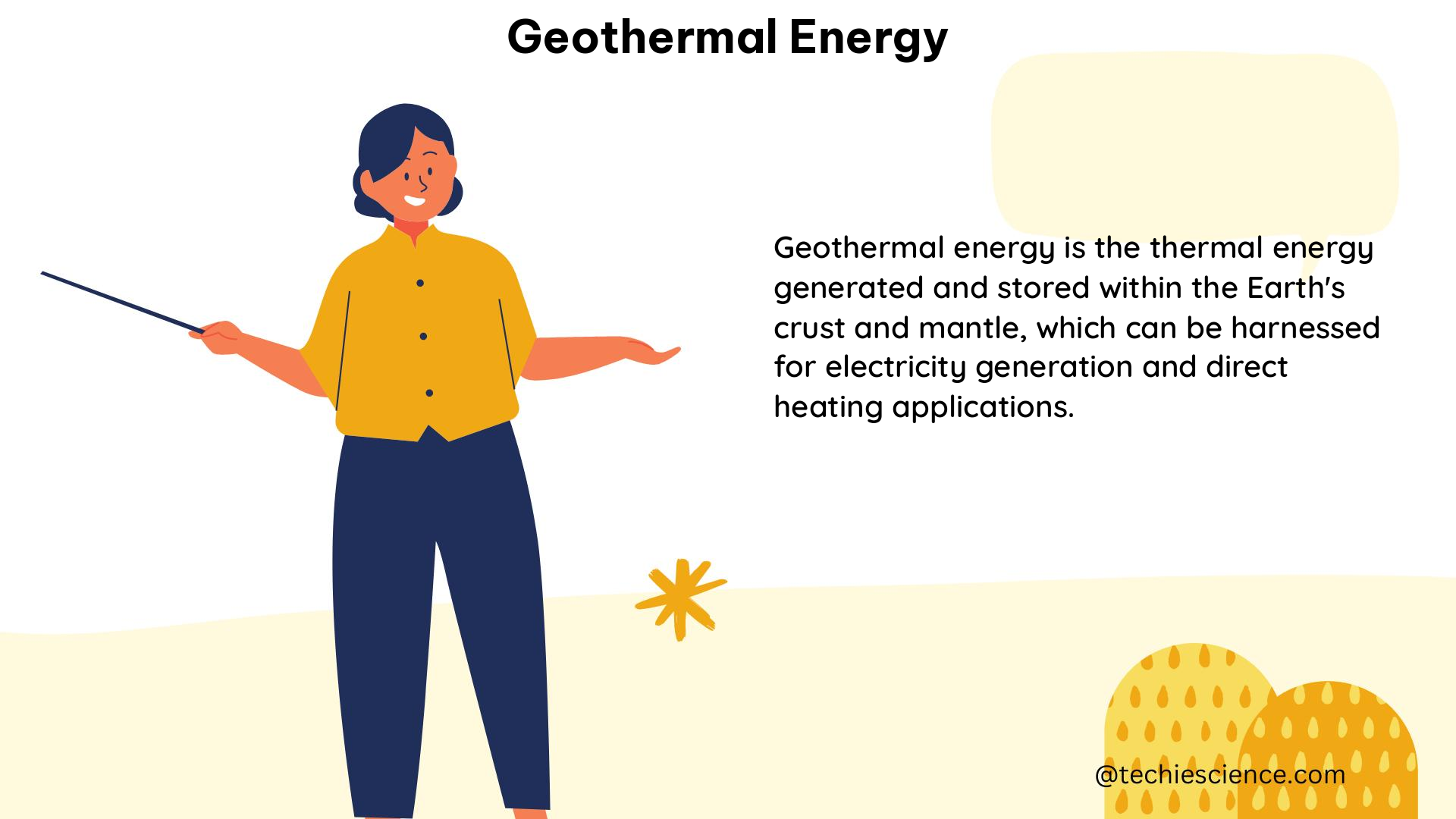Geothermal energy is a significant and growing source of renewable energy, harnessing the Earth’s internal heat to generate electricity and provide direct heating and cooling. This comprehensive guide delves into the technical details, applications, and environmental considerations of geothermal energy, equipping physics students with a deep understanding of this versatile energy resource.
Installed Capacity and Annual Utilization
The global installed direct-use geothermal capacity reached 107,727 MWt in 2020, reflecting an impressive annual growth rate of 8.73%. This capacity is utilized to generate 1,020,887 TJ of thermal energy per year, growing at an even faster rate of 11.5% annually.
The physics behind geothermal energy extraction involves the transfer of heat from the Earth’s interior to the surface, driven by the temperature gradient and the thermal conductivity of the subsurface materials. The heat flux, measured in watts per square meter (W/m²), varies depending on the geological characteristics of the region, with typical values ranging from 0.03 to 0.1 W/m² in continental regions and up to 0.3 W/m² in areas with active volcanism or tectonic plate boundaries.
To quantify the heat transfer, we can use the Fourier’s law of heat conduction, which states that the heat flux, q, is proportional to the temperature gradient, ∂T/∂x, and the thermal conductivity, k, of the medium:
q = -k * (∂T/∂x)
Where:
– q is the heat flux (W/m²)
– k is the thermal conductivity of the medium (W/m·K)
– ∂T/∂x is the temperature gradient (K/m)
The negative sign indicates that heat flows from the higher temperature region to the lower temperature region.
Geothermal Heat Pumps

Geothermal heat pumps, also known as ground-source heat pumps, play a significant role in the utilization of geothermal energy. In 2020, the installed capacity of geothermal heat pumps reached 77,547 MWt, with an annual energy use of 599,981 TJ.
The working principle of a geothermal heat pump is based on the temperature difference between the ground (or a body of water) and the desired indoor temperature. The heat pump uses a refrigerant to absorb heat from the ground (or water) and transfer it to the building, or vice versa, for cooling. The coefficient of performance (COP) of a geothermal heat pump can range from 3 to 5, meaning that for every unit of energy input, the system can deliver 3 to 5 units of thermal energy.
The COP of a geothermal heat pump can be calculated using the following formula:
COP = Q_h / W_in
Where:
– COP is the coefficient of performance
– Q_h is the heat delivered to the building (kW)
– W_in is the electrical power input to the heat pump (kW)
The high COP of geothermal heat pumps, compared to air-source heat pumps, is due to the relatively stable and moderate temperatures of the ground or water, which provide a more efficient heat source or sink.
Applications of Geothermal Energy
Geothermal energy has a wide range of applications, with the following breakdown of thermal energy usage:
| Application | Percentage of Thermal Energy Used |
|---|---|
| Geothermal (Ground-Source) Heat Pumps | 58.8% |
| Bathing and Swimming | 18.0% |
| Space Heating | 16.0% |
| Greenhouse Heating | 3.5% |
| Industrial Applications | 1.6% |
The use of geothermal energy for direct heating and cooling applications, such as ground-source heat pumps, accounts for the largest share of thermal energy usage. This is due to the high efficiency and cost-effectiveness of geothermal heat pumps compared to traditional heating and cooling systems.
In addition to direct heating and cooling, geothermal energy can also be used for industrial processes, such as drying, food processing, and chemical production. The specific applications depend on the temperature range of the geothermal resource, which can vary from low-temperature (below 90°C) to high-temperature (above 150°C) resources.
Environmental Risks and Mitigation Strategies
While geothermal energy is generally considered a clean and sustainable energy source, it does come with some environmental risks that need to be addressed:
-
Seismic Hazards: Geothermal energy extraction can potentially induce seismic activity, particularly in areas with active fault lines or volcanic regions. To mitigate this risk, detailed geological and seismic surveys are conducted to identify and avoid high-risk areas. Additionally, monitoring and management strategies, such as adjusting injection and production rates, can help minimize seismic events.
-
Human Health Risks: Geothermal fluids can contain various chemicals and gases, such as hydrogen sulfide, that can pose health risks to workers and nearby communities. Proper handling, containment, and treatment of these fluids are essential to protect human health.
-
Ecological Impacts: The discharge of thermal energy from geothermal operations can affect the temperature and chemistry of groundwater, potentially impacting local ecosystems. Careful monitoring and management of the thermal energy discharge, as well as the use of reinjection techniques, can help mitigate these impacts.
-
Economic Impacts: Environmental pollution and seismic hazards associated with geothermal energy can lead to economic losses, such as property damage, disruption of operations, and legal liabilities. Comprehensive risk assessment and mitigation strategies are crucial to minimize these economic impacts.
To address these environmental risks, geothermal energy projects often employ advanced monitoring and modeling techniques, such as:
- Subsurface Modeling: The National Renewable Energy Laboratory (NREL) has expertise in developing sophisticated subsurface models to better understand and predict the behavior of geothermal reservoirs, including the potential for induced seismicity.
- Site Operations and Optimization: Researchers focus on optimizing the operation of geothermal sites, including the management of fluid injection and production, to minimize environmental impacts.
- Energy Analysis: Techno-economic modeling and energy analysis are used to assess the feasibility and environmental impacts of geothermal energy projects, informing decision-making and policy development.
By understanding and addressing these environmental risks, the geothermal energy industry can continue to grow and provide a sustainable, reliable, and clean source of energy.
Research and Development Trends
The geothermal energy sector is actively engaged in research and development to address various technical and environmental challenges, as well as to improve the overall efficiency and cost-effectiveness of geothermal systems. Some of the key research and development trends include:
-
Subsurface Modeling and Characterization: Advances in computational fluid dynamics, rock mechanics, and geophysical imaging techniques are enabling more accurate modeling and characterization of geothermal reservoirs. This helps in identifying and assessing the viability of geothermal resources, as well as predicting and mitigating potential environmental impacts.
-
Drilling and Well Technology: Improvements in drilling techniques, materials, and well design are reducing the cost and increasing the efficiency of geothermal well construction. This includes the development of advanced drilling rigs, specialized drill bits, and innovative well completion methods.
-
Power Conversion and Efficiency: Research is focused on enhancing the efficiency of power conversion systems, such as binary and flash-steam power plants, to extract more energy from geothermal resources. This involves the development of advanced turbines, heat exchangers, and working fluids.
-
Exploration and Resource Assessment: Advancements in geophysical exploration methods, including seismic, gravity, and electromagnetic surveys, are improving the ability to identify and characterize geothermal resources, even in areas with limited surface manifestations.
-
Hybrid and Integrated Systems: Researchers are exploring the integration of geothermal energy with other renewable energy sources, such as solar and wind, to create hybrid systems that can provide a more reliable and flexible energy supply.
-
Enhanced Geothermal Systems (EGS): EGS technology aims to extract heat from geothermal resources that are not naturally permeable or productive, by creating or enhancing the permeability of the subsurface through hydraulic stimulation or other techniques.
-
Environmental Impact Mitigation: Ongoing research focuses on developing strategies and technologies to mitigate the environmental risks associated with geothermal energy, such as induced seismicity, water management, and emissions control.
These research and development efforts are crucial for advancing the geothermal energy sector, improving its technical and economic performance, and ensuring its long-term sustainability as a reliable and environmentally responsible energy source.
Conclusion
Geothermal energy is a versatile and growing renewable energy resource that offers significant potential for electricity generation, direct heating and cooling, and industrial applications. This comprehensive guide has provided a detailed overview of the technical aspects, applications, environmental considerations, and research and development trends in the geothermal energy sector.
By understanding the physics principles, numerical data, and the latest advancements in geothermal energy technology, physics students can gain a deep appreciation for the role of geothermal energy in the global energy landscape and contribute to the ongoing efforts to harness this sustainable energy source.
References
- Lund, J. W., & Toth, A. N. (2021). Direct Utilization of Geothermal Energy 2020 Worldwide Review. Geo-Heat Center, Oregon Institute of Technology.
- U.S. Department of Energy. (2015). Geothermal Power Technology Assessment. Quadrennial Technology Review 2015.
- National Renewable Energy Laboratory. (2024). Advancing Geothermal Research.
- Chen, S., Zhang, Q., Andrews-Speed, P., & Mclellan, B. (2020). Quantitative assessment of the environmental risks of geothermal energy: A review. ScienceDirect.
- Chen, S., Zhang, Q., Andrews-Speed, P., & Mclellan, B. (2020). Quantitative Assessment of the Environmental Risks of Geothermal Energy: A Review. ResearchGate.

I am Subrata, Ph.D. in Engineering, more specifically interested in Nuclear and Energy science related domains. I have multi-domain experience starting from Service Engineer for electronics drives and micro-controller to specialized R&D work. I have worked on various projects, including nuclear fission, fusion to solar photovoltaics, heater design, and other projects. I have a keen interest in the science domain, energy, electronics and instrumentation, and industrial automation, primarily because of the wide range of stimulating problems inherited to this field, and every day it’s changing with industrial demand. Our aim here is to exemplify these unconventional, complex science subjects in an easy and understandable to the point manner.